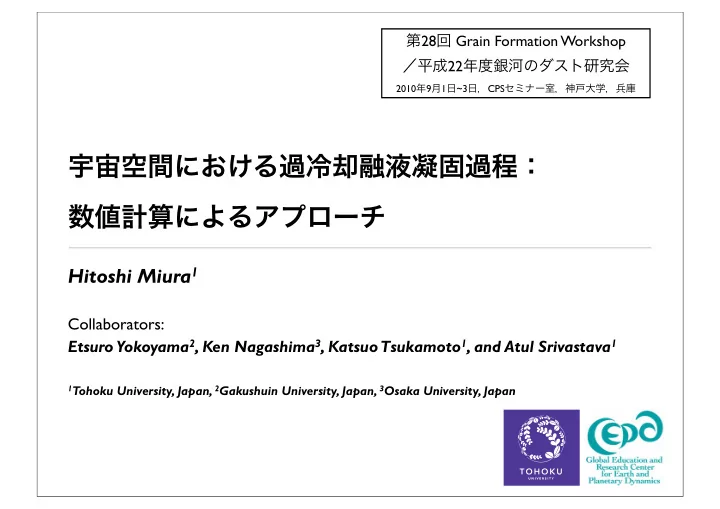

宇宙空間における過冷却融液凝固過程: 数値計算によるアプローチ 第 28 回 Grain Formation Workshop /平成 22 年度銀河のダスト研究会 2010 年 9 月 1 日 ~3 日, CPS セミナー室,神戸大学,兵庫 Hitoshi Miura 1 Collaborators: Etsuro Yokoyama 2 , Ken Nagashima 3 , Katsuo Tsukamoto 1 , and Atul Srivastava 1 1 Tohoku University, Japan, 2 Gakushuin University, Japan, 3 Osaka University, Japan
Introduction: Chondrules “olivine” (Mg x Fe 1-x ) 2 SiO 4 unique solidification texture: barred-olivine RIM shell of olivine crystal BAR elongated parallel crystals of olivine transmitted light image of thin (images from “http://jm-derochette.be/”) section of Semarkona, LL3.0 (Connolly & Love 1998, Science 280, 62) rim & bars key stone of early solar nebula the same crystallographic orientation! A mm-sized “magma” droplet cools to solidify in a short period of time. The solidification texture reflects the crystal growth process.
Introduction: Condition for rim formation? • levitation time • rapid cooling: R cool ~ 1000 K/s • supercooling ~ 1000 K Ultra-high speed TV images of a rotating crystallizing forsterite (Mg 2 SiO 4 ) melt. This crystallization process is completed within 0.1 s (Tsukamoto+1999, Antarct. Meteorites 24, 179) . First reproduction of RIM! Only bars (dendrites) inside chondrule were reproduced in 1990. However, it had no rim (Lofgren & Lanier 1990, Geochim. Cosmochim. Acta 54, 3537) . Question: How large R cool is required? Strategy: Phase-field simulations of crystallization of “rapidly-cooling” melt droplet
温度場 場 複雑な界面形状の時間発展を 結晶 液相 Method: Phase-field method double-well potential フェーズ Φ による相の区別 diffuse interface φ 比較的容易に取り扱える (Sekerka 2007) 結晶 ( φ = 0) 液相 ( φ = 1)
Method: Phase-field equations “release of latent heat” “surface cooling” ● temperature, T: latent heat of volumetric thermal crystallization heat capacity diffusivity per unit volume thickness of capillary length interface melting point (~ nm) ● phase, Φ : (model I of Wang+1993, Physica D 69, 189, modified) “simulating dynamics of crystal growth in a pure material by solving two differential equations simultaneously”
Method: Computational settings • 2D cubic cell • semicircle (and full-circle) • 1000 x 500 (1000) mesh • heat flux at droplet surface q s (determines cooling rate R cool ) • supercooled melt droplet • pure forsterite (Mg 2 SiO 4 ) • completely molten, initially • diameter = 500 um • seeded at surface supercooling Δ T s (collision with cosmic dust) • no-flux boundary condition a seed crystal Miura+2010, in prep.
Result: Cooling rate R cool required rim formation temperature profile of droplet: Temperature at the droplet surface is volumetric lower than that at the center heat capacity (temperature difference δ T c-s ). When R cool = 2800 K/s, temp. at temp. at δ T c-s = 125 K. radius r center thermal conductivity We assume that q s (R cool ) is constant. When the surface undercools by 300 K below δ T c-s = 125 K the melting point, we put a seed crystal at the surface Δ T s to initiate crystallization. = 300 K Supercooling at the center: = 175 K seeding! (Miura+2010, submitted)
Result: Crystallization pattern (R cool = 2800 K s -1 ) phase temperature cooling curve recalescence “seeding” • recalescence (rapid temperature increase) • rapid crystallization (within ~ 0.1 sec) • rapid growth along the surface (rim formation) • dendrite formation inside the droplet Miura+2010, submitted double structure: rim (along the surface) + dendrite (inside the droplet)
Result: Effect of surface cooling Cooling rate R cool [K/s] (heat flux at surface q s [erg/cm 2 /s]) 1400 (1.0 x 10 9 ) 2800 (2.0 x 10 9 ) 14000 (1.0 x 10 10 ) dendrite only rim + dendrite rim only Double structure (rim + dendrite) was formed only when R cool is in a narrow range. Crystallization timescale , t crys , reflects crystal growth velocity V . In phase-field model, crystal-liquid interface is diffuse, so it has finite width δ . “ t crys = δ / V ”
Discussion: Growth time, rim/dendrite Growth time t growth : • rim grows fast, but goes the long way droplet radius growth velocity temperature difference • dendrite grows slowly, but takes the δ T c-s shortest course supercooling at surface Δ T s normalized temp. diff. α = δ T c-s / Δ T s “dependence of growth velocity on undercooling” “temperature profile” n = 2.5 - 3.5 from theories of dendrite growth (Langer & Muller-Krumbhaar 1978; Xu 1998)
Discussion: Condition for rim formation rim only central temperature (depend on q s ) melting point T M rim + dendrite t rim = t den temperature dendrite difference only > 100 K! surface temperature (300 K below T M ) The rim was formed when R cool >~ 1300 K/s for a forsterite melt droplet of 500 um in diameter.
Conclusions • We carried out phase-field simulation of crystallization from a highly-supercooled melt droplet. • We first successfully reproduced double structure by numerical simulation, which is similar to barred olivine texture of chondrules. • The rim was formed when the cooling rate of the rim + dendrite droplet is ~ 10 3 K/s or larger, which is expected by radiative cooling . - Astrophysical model predicts a wide range of the cooling rate from 10 -3 to 10 3 K/s ! • This is the first step to elucidate the formation mechanism of chondrule solidification texture.
Recommend
More recommend